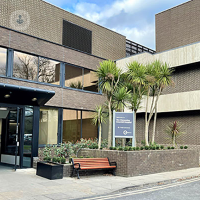Ankylosing spondylitis
Professor Hasan Tahir - Rheumatology
Created on: 11-13-2012
Updated on: 09-05-2023
Edited by: Sophie Kennedy
What is ankylosing spondylitis?
Ankylosing spondylitis is also known by the names spondylitis and rheumatoid spondylitis. It is an inflammatory joint disease of the spine and the sacroiliac, which is found at the junction of the pelvis to the spine. Sometimes, the condition can cause some of the bones of the spine (vertebrae) to fuse together, which can make the spine less flexible.

What causes ankylosing spondylitis?
There is no known, exact cause of ankylosing spondylitis. People born with the HLA-B27 gene are far more likely than others to develop the condition, but this not true in all cases. In terms of risk factors, men are more likely to develop the condition than women. The symptoms of ankylosing spondylitis usually appear in early adulthood.
What are the symptoms of ankylosing spondylitis?
The first symptoms of the disease are:
- back pain and stiffness
- pain or swelling in the buttocks
- neck pain
- fatigue
- pain and redness in the eye
- increased light sensitivity
- blurred vision
It is important to note that in cases of ankylosing spondylitis, the pain felt in the neck, back and buttocks improves with exercise and worsens with rest. Additionally, the pain can be severe enough to wake those who suffer from the condition during the night and will likely be worse in the mornings or after periods of inactivity.
You should visit your doctor if you notice any of these symptoms, even if they are not consistent, as the signs of ankylosing spondylitis can become worse, improve and temporarily stop over time.
How does ankylosing spondylitis progress?
As a consequence of the fusion of the spine, patients may experience a loss of mobility and progressive joint deformity, including a hunched posture. This can be increased by compression fractures, caused by the disease's weakening effect on bones.
Additionally, some patients may have an eye inflammation (uveitis). This is the most common complication of ankylosing spondylitis which will require specialist treatment from an ophthalmologist.
Abnormal heart valves and their complications are also associated with ankylosing spondylitis. This happens as a consequence of the aorta becoming inflamed which can lead the aortic chambers to become distorted.
Is ankylosing spondylitis treatable or curable?
Back pain from mechanical causes (like spondylosis) is far more common than inflammatory diseases. Because of this, there sadly still a long delay in getting a diagnosis for patients with spondylitis. It is crucial therefore to be seen by a specialist if you have features that best fit an inflammatory cause so that your symptoms can be properly investigated and treatment, if appropriate, commenced.
As an initial intervention, most patients will be offered non-steroidal anti-inflammatory medication (NSAIDs) like Ibuprofen or Naproxen. While these are common painkillers, you may need to use these regularly every day to get the best effects. Because of this, patients commonly need protection for their stomach with treatments like Omeprazole.
Because this is a long-term disease, it is vitally important to learn more about your condition and how best to manage it. A specialist programme with a physiotherapist involving education and exercise is usually part of the treatment.
For individuals with more persistent disease, newer targeted agents such as biological therapies can be prescribed. This includes medication like anti-TNF drugs, IL-17 drugs and JAK inhibitors.
What type of doctor treats ankylosing spondylitis?
A specialist rheumatologist treats ankylosing spondylitis. Specialist cardiologists and ophthalmologists treat the condition’s complications.















